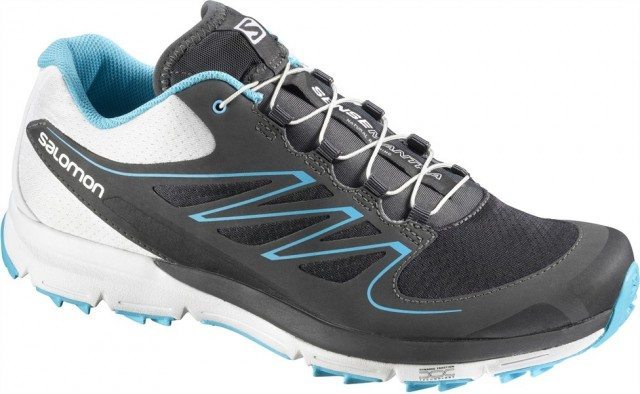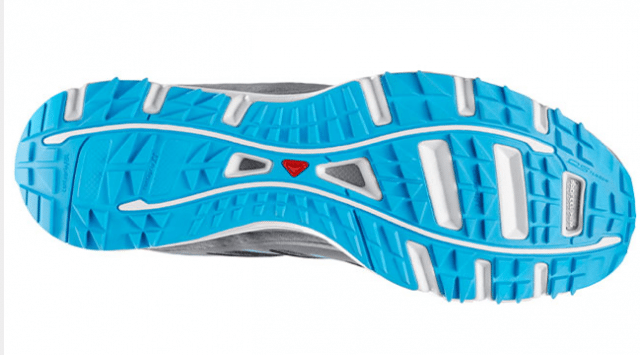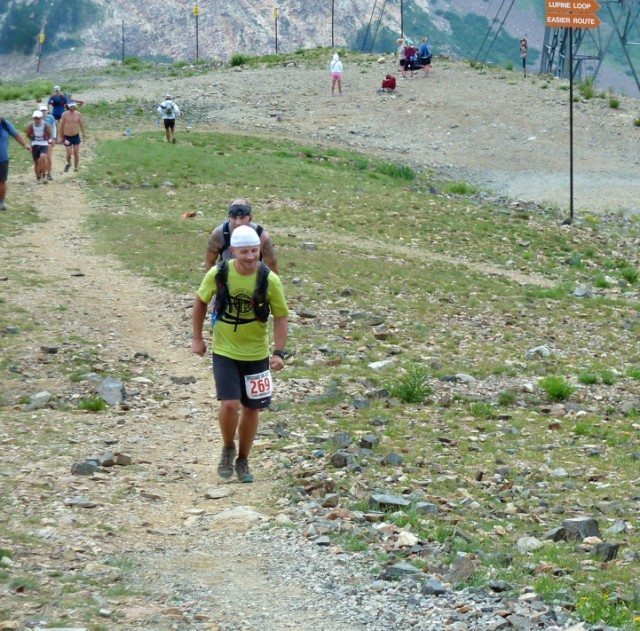
Shoe: 2013 Salomon Sense Mantra
Size: 8.5
Weight: 9.5 oz.
Heel-to-Toe Drop: 6 mm
MSRP: $120
Reviewer’s Feet: 260mm / D-width
Test Duration: ~ 8 weeks
Total Miles Run: ~ 400
Test Locations: Wasatch and Uinta Mountains, Utah
Early this summer, I registered for my first ultra-marathon (the Wasatch Speedgoat 50K), but I didn’t have a pair of shoes I felt comfortable racing 11,000+ vertical in.
I’d been optimistic about how the New Balance MT1010 would perform, but its abrupt deterioration meant I wouldn’t be running Speedgoat in it.
The pair of Hoka Stinson Evos sitting in my closet were an option, but, since Salomon has gained a lot of credibility among the mountain running crowd recently, I wanted to see what the hype was all about.
I like my trail shoes light and low, with a good balance of trail feel and cushioning. Salomon markets the Sense Mantra as a “lightweight training shoe for midfoot strikers who want natural motion, protection and neutral cushioning for high mileage training.” Sounds about right.

The Shoe
The Sense Mantra is new to Salomon’s 2013 trail running lineup, and, while it has a lot of the same technology as the high-end S-Lab shoes, it fits in the company’s “door-to-trail” category. The Mantra looked like a burly shoe that would get me through a lot of tough miles, and I though it might be a good fit for those looking to transition into minimal running.
My initial impression of the Mantra was that it was simply a more substantial shoe than I had been running in (NB Minimus line). It’s a little heavier (2 oz.), has a little more drop (6 mm compared to 4 mm), and feels a little more like a traditional trail shoe. For a second, I found myself debating whether or not I was going to be okay adding 2 mm more drop than I’m accustomed to, then told myself that I’m really not one of those runners and moved on.
Fit / Sizing
The Mantra has both Endofit and Sensifit. That means there is a “sleeve” within the shoe that ensures a snug, precise fit. In my experience, the fit was great right out of the box, and was true to size at 8.5.
I’m used to a shoe with a “socklike” fit, and I found the Mantra felt a little different—there’s more shoe than New Balance’s MT1010 or MT110, but still less than a traditionally cushioned road or trail shoe.
Outsole / Cushioning
I picked up the Mantra when I was ramping up training mileage to 40-50 miles a week, and I first tested them on a mellow, dry 8-mile loop in Park City, Utah. I define a good shoe as one I don’t think about while running, and by this standard, the Mantra performed very well on this first run, albeit on easy terrain (few rocks, not terribly steep).
The outsole gripped well on the dry terrain, and the shoe let my foot fall naturally with a mid-foot/forefoot strike as I’d hoped. I was surprised that I noticed the difference between 4mm and 6mm of drop. There is noticably more shoe under heel than I was used to, but definitely not so much that it was an issue.
The cushioning in the Sense Mantra from heel to toe is noticeably softer than the firm, responsive cushioning in the NB MT 1010. I typically prefer firmer cushioning, but in this case it wasn’t a deal breaker.
Confident that I wouldn’t regret using the Mantra for longer distances, I began tackling my favorite run—a 10-mile, 3000-vertical ft. loop between Alta and Brighton, Utah that features a mix of steep, rocky terrain, occasional mud, and some buff singletrack and road.
I found myself thanking the small amount of cushioning during the rocky descents, as well as the ProFeel film for filtering out harsh trail feedback. The Mantra still felt light and nimble on the smooth, fast singletrack and road descents.
The Contagrip outsole has performed well on virtually every surface (dirt, roots, rocks, mud, pavement) with the exception of steep, loose, kitty litter where I’d prefer to have a bit more of a lug. But I think this is an acceptable trade-off to have a sole that’s appropriate for 90% of the terrain that I run.

I have taken the Mantra on two long runs—a 28-mile adventure run to King’s Peak, Utah, and the 31-mile Speedgoat race at Snowbird Ski Resort. The best thing I can say about the Mantra is that the shoe was the last thing on my mind either time.
The Speedgoat course is very technical, with some nice singletrack thrown in. While I may have preferred the Hoka when I tried to charge down the talas trails, it has almost no trail feedback and is not a shoe I want to spend all day in.
And although I love the sock-like feel of the MT110 on singletrack, I would have regretted it when the terrain got rough, as it often did.
Breathability
While I don’t typically notice a shoe’s breathability, the Mantra is a little warm. On 2+ hour early summer runs, I sweated through the mesh on the upper, which I haven’t experienced with the NB Minimus line. But the upper has seemed significantly more durable than that of the Minimus…
Durability
Virtually all of my nearly 400 miles in the Mantra have been hard miles, and I suspect the shoes will still be going strong for some time. Despite a lot of time spent running over rocks, they are still mostly intact, save for a little bit of tearing in the upper and some wear on the outsole.
The cushioning in the heel and forefoot is not quite as supple as it was when I picked them up, but that’s not an issue for me, especially since I prefer a more firm ride.

A Quick Note on Speedlaces
I would prefer traditional laces over the Speedlaces. I’ve never saved time by using them, and I always have to adjust them on trail since it’s hard to apply pressure to the individual courses of lace. But Salomon’s laces were much easier to adjust than those on the Hoka Stinson Evo.
Bottom Line
The Sense Mantra is marketed as a lightweight trail shoe for high-mileage training, and that’s exactly where it excels.
I suspect that the Mantra might be a good fit for those looking to transition slowly into minimal running. If you’re coming from a heavier shoe with a traditional drop (10-12mm), the 6mm Mantra is going to feel far less foreign than many of the 4mm slippers out there today.
I initially found myself skeptical of the slightly softer, more cushioned feel than I’m used to, but I quickly forgot about the subtle differences and was glad that I did.
The Mantra feels, to me, like a “one-shoe” quiver—a trail shoe I wear when I’m not sure what to expect, or when I’m expecting a little of everything.

a query about the amount of space withing the shoe; is there enough room to fit in an 8mm raise? ive got such a raise for a leg-length differential and some shoes end up being a fairly tight fit. for comparison’s sake im currently wearing inov-8 195s and despite it being a trail racing shoe the fit is fine after some wearing in.